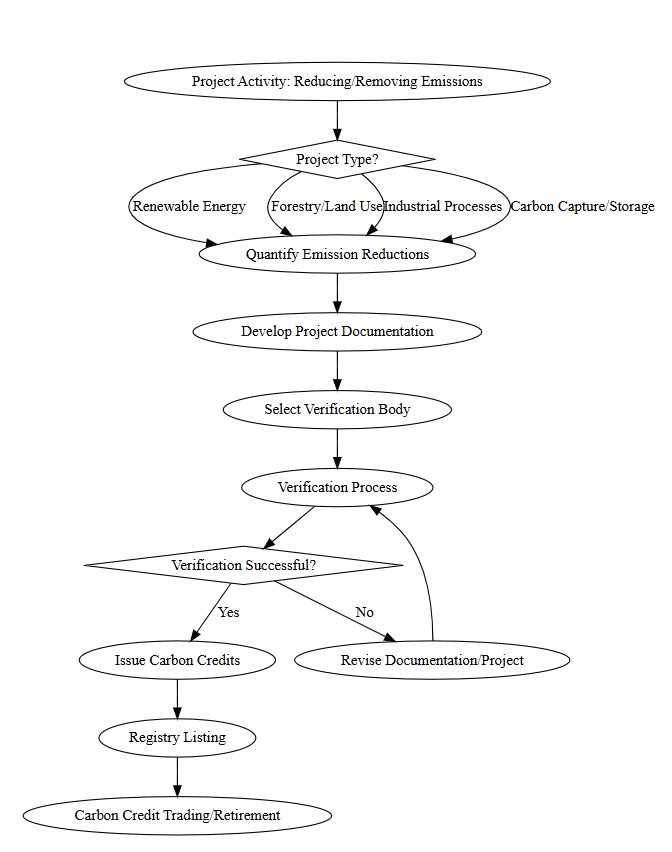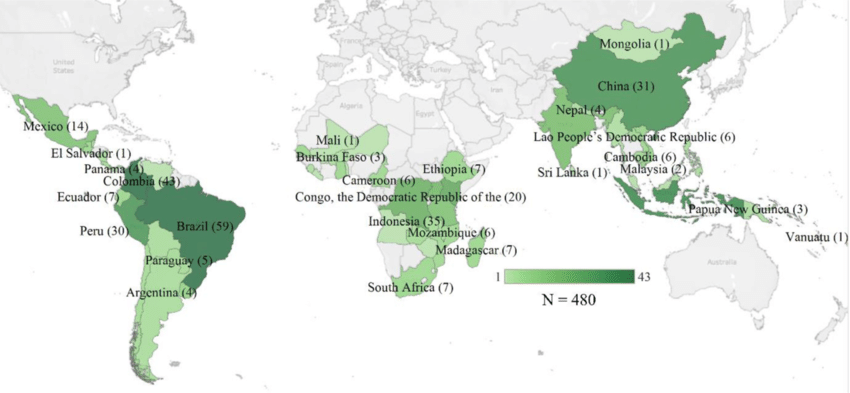Table of Contents
ToggleWhat Exactly Are Carbon Credits? Breaking Down the Basics
The Definition of Carbon Credits
In the ongoing global effort to combat climate change, a crucial instrument has emerged: the carbon credit. But what exactly is this intangible asset, and how does it function? At its core, a carbon credit represents a measurable and verifiable reduction in greenhouse gas (GHG) emissions resulting from certified climate action projects. These projects actively work to reduce, avoid, or even remove harmful GHGs from our atmosphere. Think of it as a permit, but instead of allowing pollution, it signifies that a specific amount of pollution – precisely one metric tonne of carbon dioxide (CO2) or its equivalent in other greenhouse gases (CO2e) – has been either prevented from entering the atmosphere or actively taken out of it.
When a business or government emits greenhouse gases, they are essentially contributing to the warming of our planet. Carbon credits provide a mechanism to counterbalance these emissions. By purchasing a carbon credit, an organization is essentially supporting a project that has reduced or removed an equivalent amount of CO2e elsewhere. This purchase grants the organization a sort of permission to emit that equivalent amount. The money generated from the sale of these credits is then channeled back into further carbon reduction or removal projects, creating a positive feedback loop in the fight against climate change. This system introduces a tangible monetary value to the act of reducing or removing greenhouse gases, making environmental responsibility an economically relevant factor for businesses and governments alike.

The beauty of carbon credits lies in their standardized nature. The consistent emphasis on “one metric ton of CO2 equivalent” across various definitions establishes a universal unit of measurement within the carbon credit market. This standardization is paramount. Different greenhouse gases possess varying levels of heat-trapping potential. By converting them into a common metric of CO2 equivalent, it becomes possible to establish a unified system for accounting and trading emission reductions. This allows for a clear and consistent comparison of the climate impact of diverse mitigation projects, fostering transparency and facilitating effective climate action on a global scale.
Furthermore, the purpose of a carbon credit extends beyond mere compensation for emissions. It acts as a vital financial lifeline for projects dedicated to reducing or removing GHGs. This dual function is the engine of the carbon market: it empowers emitters to take responsibility for their environmental footprint while simultaneously directing crucial financial resources towards initiatives that actively combat climate change. This creates a powerful economic incentive for the development and implementation of environmentally friendly projects that might not otherwise be financially viable, driving innovation and investment in a greener future.
The Purpose Behind Carbon Credits: Mitigating Climate Change
Carbon credits have emerged as a crucial tool in the global strategy to mitigate the escalating crisis of climate change. They offer a flexible and economically viable pathway for both companies and individuals to take tangible action in reducing overall greenhouse gas emissions. By providing a way to offset unavoidable emissions and channel finance into projects that actively reduce, remove, or avoid these gases, carbon credits are helping humanity “bend the climate curve”. This innovative approach aims to meet the urgent need to address a catastrophically warming planet while strategically directing climate investments to the regions and communities where they are most needed to facilitate a just energy transition.
For organizations that are significant emitters of greenhouse gases but face challenges in immediately eliminating their emissions, carbon credits serve as a vital “bridge”. This suggests that carbon credits are not intended as a permanent license to pollute but rather as a temporary mechanism to compensate for emissions that cannot yet be eliminated, while these organizations actively work towards deeper decarbonization within their own operations. This distinction is crucial in ensuring that carbon credits are used responsibly and do not simply become a tool for greenwashing.
The purpose of carbon credits extends beyond just the reduction of emissions. They also play a significant role in supporting broader sustainable development goals, fostering community benefits, and facilitating the transfer of clean technologies, particularly to developing countries. This broader perspective highlights the potential for carbon credit projects to generate multiple positive impacts that go beyond climate mitigation. For instance, a project focused on providing clean cookstoves might not only reduce carbon emissions but also improve air quality and health outcomes for local communities. Similarly, investments in renewable energy projects in developing nations can contribute to both emissions reductions and improved access to clean and affordable energy.
However, it’s important to acknowledge the underlying tension between the potential of carbon credits and the legitimate concerns surrounding their actual effectiveness and the risk of greenwashing. The question of whether these credits truly represent genuine emission reductions or if the claimed effects are merely illusory is a pressing one. This necessitates a strong emphasis on ensuring the high integrity of carbon credits and establishing robust verification processes to guarantee that the claimed benefits are real and not just a way for polluters to avoid making meaningful emissions cuts at their source.
Decoding the Different Flavors of Carbon Credits
Carbon credits aren’t a one-size-fits-all solution. They come in different types, each representing a distinct way of tackling greenhouse gas emissions. Understanding these nuances is key to appreciating their role in climate action.
Avoidance Credits: Preventing Emissions Before They Happen
Avoidance credits are generated by projects that proactively prevent the release of greenhouse gases into the atmosphere. Instead of dealing with emissions that have already occurred, these initiatives focus on stopping them from happening in the first place. This approach is often seen as crucial for achieving immediate climate impact by nipping potential emissions in the bud.

Examples of Avoidance Projects
One common example is the development of renewable energy infrastructure, such as building wind farms or solar power plants. By generating electricity from clean sources like wind and sunlight, these projects directly displace the need for energy produced from fossil fuels, thus avoiding the associated carbon emissions. Repairing leaky boreholes to provide access to clean water, thereby eliminating the need for boiling water over open fires, is another example. This simple act prevents the burning of firewood and the subsequent release of carbon dioxide.
Preventing deforestation, often through initiatives like REDD+ (Reducing Emissions from Deforestation and Forest Degradation), also falls under this category. Forests act as significant carbon sinks, absorbing and storing vast amounts of CO2. By protecting these natural carbon reservoirs from being cleared, we avoid the release of the stored carbon into the atmosphere. Furthermore, projects focused on energy efficiency improvements in buildings, factories, or transportation systems also generate avoidance credits by reducing overall energy consumption and the associated emissions. Distributing clean and efficient cookstoves that require less fuel than traditional methods is another impactful example, particularly in developing countries where reliance on burning wood or charcoal is high. Lastly, capturing methane emissions from landfills and utilizing it as an energy source prevents this potent greenhouse gas from entering the atmosphere, generating avoidance credits.
While avoidance projects are vital for preventing future emissions, some concerns have been raised. For instance, if an organization purchases avoidance offsets, it might technically be considered “carbon neutral” for those specific emissions. However, the organization itself might still be engaging in activities that release carbon dioxide into the atmosphere. In such cases, the purchase of avoidance credits doesn’t necessarily translate to an actual reduction in the buyer’s own emissions or drive fundamental changes in their operational practices. This highlights the importance of ensuring that avoidance credits are part of a comprehensive climate strategy that prioritizes reducing emissions at the source alongside offsetting.
Reduction Credits: Lowering the Amount of Greenhouse Gases
Reduction credits, in contrast to avoidance credits, are earned by projects that actively decrease the amount of greenhouse gas emissions compared to prior practices or a defined baseline. These projects focus on making existing processes and technologies less carbon-intensive, leading to a measurable decline in emissions.
Examples of Reduction Projects
Improving energy efficiency across various sectors is a prime example. This can involve upgrading equipment to more efficient models, optimizing industrial processes to reduce energy consumption, or implementing better insulation in buildings to lower heating and cooling needs. Transitioning to renewable energy sources, while also considered an avoidance strategy, can also be framed as a reduction compared to previous reliance on fossil fuels.
Reforestation and afforestation initiatives, which involve planting trees in deforested areas or in areas that were never forested, respectively, are often categorized under reduction credits, although they also actively remove carbon from the atmosphere. Similarly, forest conservation efforts, including REDD+ projects, can be seen as reducing potential emissions by preventing deforestation. Projects focused on capturing methane emissions from sources like farms and municipal waste processing and either destroying it or utilizing it for energy production also fall under reduction credits.
Other examples include adopting sustainable agricultural land management practices that reduce emissions from farming activities , implementing industrial process emissions reduction technologies , switching to renewable fuels with lower carbon intensity , and avoiding the conversion of grasslands and wetlands, which store significant amounts of carbon. Even projects focused on improving transportation efficiency or promoting the use of lower-carbon transportation methods can generate reduction credits. The destruction or replacement of ozone-depleting substances, which are potent greenhouse gases, also contributes to emission reduction.
The distinction between avoidance and reduction credits can sometimes be nuanced. For instance, switching to renewable energy can be seen as avoiding future emissions from fossil fuels, but it also represents a reduction in the carbon intensity of energy production compared to previous methods. This overlap suggests that the classification of a project might depend on the specific methodology used to quantify its climate impact or the primary goal it aims to achieve. Ultimately, both avoidance and reduction projects play a vital role in curbing greenhouse gas emissions.
Removal Credits: Sucking Carbon Dioxide Out of the Air
Removal credits represent a more direct approach to tackling climate change by focusing on physically removing greenhouse gases, primarily carbon dioxide, from the atmosphere and storing them for the long term. This category encompasses a range of innovative solutions, from nature-based approaches to cutting-edge technological advancements.
Examples of Removal Projects
Nature-based solutions are prominent in the realm of carbon removal. Reforestation and afforestation, already mentioned under reduction, are also powerful carbon removal methods as growing trees absorb CO2 from the air through photosynthesis and store it in their biomass and the soil. Protecting and restoring coastal and marine ecosystems like mangroves, seagrasses, and salt marshes, known as “blue carbon” projects, are also highly effective at sequestering and storing large amounts of carbon in their biomass and sediments. Implementing regenerative agriculture practices on farmlands can enhance the soil’s ability to capture and store carbon.

On the technological front, Direct Air Capture and Storage (DACCS) involves capturing CO2 directly from the ambient air using specialized machinery and then permanently storing it underground or in durable products. Biochar production involves heating biomass in a low-oxygen environment to create a stable, carbon-rich material that can be added to soil, sequestering carbon for centuries while also improving soil health. Bioenergy with Carbon Capture and Storage (BECCS) combines the production of energy from biomass with the capture and geological storage of the CO2 released during the process. Enhanced rock weathering involves spreading finely ground silicate rocks on land to accelerate the natural process of CO2 absorption. Other emerging technologies like mineralization and marine carbon capture are also being explored for their carbon removal potential.
While nature-based removal solutions are currently more prevalent and often more cost-effective , they can face challenges related to the long-term permanence of carbon storage. For example, forests are vulnerable to wildfires or deforestation, which could release the stored carbon back into the atmosphere. In contrast, engineered solutions like DACCS offer the potential for highly durable carbon storage, often for hundreds or even thousands of years. However, these technologies are generally more expensive and currently have limited scalability. The increasing focus on developing and scaling up a diverse portfolio of carbon removal methods signifies a growing understanding that both reducing emissions and actively removing existing CO2 from the atmosphere will be essential to achieving our climate goals.
| Type of Carbon Credit | Description | Examples of Project Types |
|---|---|---|
| Avoidance Credits | Prevent the release of greenhouse gases into the atmosphere. | Renewable energy projects (wind, solar, hydro), energy efficiency upgrades, preventing deforestation (REDD+), clean cookstove initiatives, methane capture from landfills. |
| Reduction Credits | Decrease the amount of greenhouse gas emissions compared to prior practices. | Improving energy efficiency, transitioning to renewable energy, reforestation and afforestation, methane capture, sustainable land management practices, industrial process emissions reduction, renewable fuel switch, avoided conversion. |
| Removal Credits | Actively remove greenhouse gases from the atmosphere and store them. | Reforestation, afforestation, mangrove restoration, soil carbon sequestration, direct air capture and storage (DACCS), biochar production, bioenergy with carbon capture and storage (BECCS), enhanced rock weathering. |
The Buzz Around Carbon Credits: Current Discussions and Trends
Effectiveness and Criticisms: A Balanced View
The topic of carbon credits is currently buzzing with discussions and debates, particularly regarding their actual effectiveness in driving down global greenhouse gas emissions and the criticisms leveled against them. While proponents argue that they are a crucial tool for channeling finance towards climate action and facilitating the transition to a low-carbon economy , critics raise valid concerns about their environmental integrity and the potential for misuse.
One of the primary criticisms revolves around the issue of “additionality”. For a carbon credit to be legitimate, the emission reduction or removal it represents must be additional – meaning it would not have occurred without the incentive created by the revenue from selling carbon credits. If a project would have been implemented anyway due to other market forces or regulations, then the carbon credits generated do not represent a genuine additional benefit to the climate. Ensuring additionality requires rigorous assessment and can be challenging to verify in practice.
Concerns have also been raised about the potential for overestimation of emission reductions, particularly in certain project types like clean cookstoves and avoided deforestation. Studies have indicated that the actual emission reductions achieved by some projects may be significantly lower than the number of carbon credits issued, leading to a situation where the claimed climate benefits are overstated. This overestimation can undermine the effectiveness of carbon markets and even worsen climate change if companies rely on these “phantom credits” to offset their emissions instead of making real reductions.
The lack of standardization, transparency, and robust monitoring and verification processes in the voluntary carbon market has also been a significant point of criticism. The market is largely unregulated, making it difficult for buyers to assess the quality and impact of different carbon credits. This lack of transparency can lead to a lack of trust in the veracity of offset claims and increase the risk of “greenwashing,” where companies use ineffective carbon credits to claim environmental responsibility without making substantial changes to their own emissions.
Furthermore, issues like “leakage,” where emission reductions in one area are offset by increases elsewhere, and the challenge of ensuring the long-term “permanence” of carbon storage, particularly in nature-based solutions like forestry, add to the complexities and criticisms surrounding carbon credits. Price volatility in carbon markets can also weaken the incentive for long-term investments in sustainable technologies.
Despite these criticisms, there is a broad recognition of the potential role that high-integrity carbon credits can play in mobilizing finance for climate action and supporting the transition to a low-carbon economy. The key lies in ensuring that carbon credits are generated from projects that are truly additional, accurately measured, rigorously verified, and deliver lasting climate benefits. Initiatives like the Integrity Council for the Voluntary Carbon Market (ICVCM) and the development of Core Carbon Principles (CCPs) are crucial steps towards addressing these concerns and establishing a more credible and effective voluntary carbon market. These efforts aim to set a global benchmark for high-quality carbon credits, making it easier for buyers to identify and invest in projects that make a genuine impact on emissions reduction and removal.
Market Trends in 2024 and Beyond
The carbon credit market is currently undergoing a period of dynamic change, with significant growth projected in the coming years, although estimates vary across different reports. This anticipated expansion is driven by a confluence of factors, including increasing government regulations aimed at reducing carbon footprints , growing corporate commitments to achieving net-zero emissions , and a rising demand for sustainability from both investors and consumers.
A key trend observed in the market is a growing emphasis on the quality and integrity of carbon credits. Buyers are increasingly prioritizing credits from projects that demonstrate high levels of transparency, have a measurable impact, and adhere to recognized standards and principles, such as the ICVCM’s Core Carbon Principles. This shift reflects a greater awareness of the criticisms surrounding lower-quality credits and a desire to invest in projects that deliver genuine environmental benefits and avoid the risk of greenwashing. As a result, high-quality carbon credits are beginning to command premium prices in the market.
Another significant trend is the increasing attention being paid to carbon removal technologies and the credits they generate. While historically, the market has been dominated by emission reduction and avoidance credits, there is a growing recognition of the crucial role that carbon removal will need to play in achieving net-zero emissions targets and even reversing some of the effects of past emissions. Projections suggest that the market value of carbon removal credits could grow rapidly in the coming years, potentially matching or even exceeding that of emission reduction credits. This trend is driving investment and innovation in a diverse range of carbon removal solutions, from nature-based approaches like afforestation and soil carbon sequestration to engineered technologies like direct air capture and biochar.
Furthermore, there is an expectation of greater integration between voluntary and compliance carbon markets in the future. This convergence could lead to increased regulatory oversight of the voluntary market and potentially create a more level playing field in terms of standards and quality requirements. Developments related to Article 6 of the Paris Agreement are also expected to play a significant role in shaping the future of carbon markets, particularly in the compliance sector, by establishing frameworks for international cooperation and the transfer of emission reduction results.
While the overall outlook for the carbon credit market is positive, with substantial growth anticipated, there are still challenges to navigate. Oversupply of certain types of credits could continue to exert downward pressure on prices in the short term. Price volatility due to fluctuations in supply and demand, as well as political and economic uncertainties, remains a potential restraint on market growth. However, the increasing focus on quality, the growing demand for carbon removal, and the evolving regulatory landscape suggest that the carbon credit market is approaching a significant tipping point, poised for continued expansion and transformation in the years to come.
From Idea to Credit: How Carbon Credits Are Generated and Verified
The Generation Process: Creating Emission Reductions
The journey of a carbon credit begins with an idea – a project that aims to reduce, avoid, or remove greenhouse gas emissions. This could be anything from building a solar farm to planting trees or implementing more efficient industrial processes. The crucial first step in generating carbon credits is to ensure that the project meets the stringent criteria and methodologies established by recognized carbon standards.
For projects in the voluntary carbon market, a key principle is “additionality”. This means that the emission reductions or removals achieved by the project must be demonstrably additional to what would have occurred under a “business-as-usual” scenario. Project developers need to prove that the carbon finance generated by the sale of credits is essential for the project to be viable. This could involve demonstrating that the project faces financial barriers or that it goes beyond existing regulatory requirements.
Once a project concept is developed, it needs to be registered with an internationally recognized carbon standard, such as the Verified Carbon Standard (VCS) or the Gold Standard. This involves submitting detailed documentation about the project’s design, methodology for calculating emission reductions, and plans for monitoring its performance. The project then undergoes a process of validation by an independent third-party auditor, who assesses whether the project plan meets the requirements of the chosen standard. If the validation is successful, the project is registered, and implementation can begin.
As the project operates, it generates emission reductions or removals, which need to be carefully monitored and measured according to the methodology outlined in the project documentation. This data is then compiled and submitted for verification by another independent third-party auditor. The verifier assesses whether the claimed emission reductions or removals have actually occurred and if the project has been implemented as planned. If the verification is successful, the carbon standard issues a corresponding number of carbon credits, which are typically deposited into the project developer’s account in an electronic registry. These credits can then be sold on the carbon market to organizations or individuals looking to offset their emissions or support climate action.

Ensuring Integrity: The Role of Verification Standards
Ensuring the integrity of carbon credits is paramount to their effectiveness as a climate mitigation tool. This is where verification standards come into play. These standards, developed and managed by organizations like Verra (VCS), the Gold Standard, the Climate Action Reserve (CAR), and the American Carbon Registry (ACR), provide a robust framework for ensuring that carbon credits represent real, measurable, additional, unique, permanent, and independently verified emission reductions or removals.
These standards establish rigorous criteria that carbon offsetting projects must meet throughout their lifecycle, from initial design to ongoing monitoring and verification. They define key concepts like additionality, permanence (the longevity of carbon storage), and leakage (unintended increases in emissions outside the project boundary). Furthermore, they provide detailed methodologies for different types of projects, outlining the specific procedures and calculations required to quantify emission reductions accurately.
The Integrity Council for the Voluntary Carbon Market (ICVCM) has recently introduced its Core Carbon Principles (CCPs), which aim to serve as a global benchmark for high-integrity carbon credits in the voluntary market. These ten fundamental principles cover aspects such as effective governance, robust quantification of emission reductions and removals, the avoidance of double counting, and the delivery of positive sustainable development impacts. The CCPs are designed to raise the bar for carbon credit quality and provide greater clarity and confidence for buyers by setting a consistent threshold for environmental and social integrity.
The existence of multiple reputable verification standards offers project developers a choice but also underscores the importance for buyers to understand the nuances and rigor of each standard. Different standards may have varying levels of stringency in their criteria for key aspects like additionality and permanence. Therefore, buyers need to conduct thorough due diligence to select credits certified by standards that align with their own integrity requirements and risk tolerance. Understanding the specific rules and methodologies of each standard is crucial for making informed decisions and ensuring that carbon credit purchases contribute to meaningful and verifiable climate action. The emergence of the Core Carbon Principles represents a significant step towards harmonizing these standards and providing a more unified framework for ensuring high-integrity carbon credits in the voluntary market.
Third-Party Auditors: Guardians of Carbon Credit Quality
Independent third-party auditors, often referred to as Validation and Verification Bodies (VVBs), play a vital role in further ensuring the credibility of carbon credits. These accredited experts are crucial in providing an objective assessment of carbon credit projects at various stages of their development and implementation.
During the validation phase, which occurs before a project is implemented, VVBs assess the project plan to ensure that it meets the rules and requirements of the chosen carbon standard and that the proposed methodology for calculating emission reductions is sound. This includes checking for additionality and assessing the project’s potential environmental and social impacts. A successful validation leads to the project’s registration with the carbon standard.
Once the project is operational and generating emission reductions or removals, the VVB returns for the verification phase. This involves a thorough review of the project’s monitoring data and implementation to confirm that the claimed climate benefits have actually been achieved and that the project has been carried out as planned. Auditors may conduct site visits to verify the data and ensure compliance with relevant local regulations. Only after successful verification by a VVB does the carbon standard issue the corresponding carbon credits.
The requirement for this independent third-party oversight is a cornerstone of ensuring the integrity of the carbon credit market. It helps to mitigate the risk of bias or overestimation of impact by project developers, providing an objective and expert assessment of the project’s climate benefits. Many VVBs are accredited to international standards like ISO 14065 , which further enhances the credibility of the verification process by ensuring that auditors possess the necessary competency and adhere to high standards of quality management in their work. This rigorous process of validation and verification by independent third parties is essential for building trust among buyers and stakeholders in the reliability and effectiveness of carbon credits as a tool for climate action.
Real-World Impact: Successful Carbon Credit Projects Across Domains
Carbon credits are not just theoretical constructs; they are driving real and impactful projects across various sectors, contributing to tangible reductions and removals of greenhouse gas emissions.
Forestry: Protecting and Growing Our Carbon Sinks
Forestry projects have long been a cornerstone of the carbon credit market, leveraging the natural ability of trees and forests to absorb and store vast amounts of carbon dioxide from the atmosphere. These projects encompass a range of activities, from protecting existing forests at risk of deforestation to improving forest management practices and increasing forest cover through reforestation and afforestation.
Examples of Successful Forestry Projects
REDD+ projects, which incentivize the reduction of emissions from deforestation and forest degradation, have emerged as a significant model in forestry. By providing financial value to standing forests, these initiatives help to shift economic incentives away from deforestation and towards sustainable forest management. For example, the Katingan Mentaya Project in Indonesia protects around 157,000 hectares of peatland forest, a vital carbon sink, by implementing legal frameworks, monitoring, and engaging with local communities. Revenue generated from carbon credits in such projects often funds social, educational, and health programs for local communities, further enhancing their sustainability.
In Alaska, the Ahtna Native corporation partnered with Finite Carbon to develop a forest carbon sequestration project, aiming to receive payment for protecting their forest resources. This initiative highlights how indigenous communities can benefit from the carbon market by leveraging their traditional stewardship of the land. Similarly, the Afognak Forest Carbon Project in Alaska was the first successful project of its kind in the state.
Organizations like Green Timber Consulting Foresters work directly with landowners to help them navigate the complexities of the carbon market and sell credits generated from well-managed forests. Programs like the Family Forest Carbon Program and CORE Carbon by FiniteCarbon provide avenues for landowners, even those with smaller holdings, to participate in carbon credit initiatives. Improved Forest Management (IFM) projects focus on implementing sustainable forestry practices to enhance carbon sequestration beyond “business as usual” scenarios.
The Nature Conservancy’s Africa Forest Carbon Catalyst supports the development of high-quality carbon projects across Africa, including forest protection and restoration, blue carbon projects focused on mangroves, and agroforestry initiatives that integrate trees into farming landscapes. In Kenya, the Kasigau Corridor project protects over 200,000 hectares of dryland forest, generating over 1 million carbon credits through preventing deforestation and promoting sustainable land management. Even innovative technologies like seed ball deployment via drones are being used in large-scale reforestation projects in Asia, demonstrating the evolving approaches to forestry-based carbon sequestration.

Renewable Energy: Powering a Cleaner Future
Renewable energy projects, such as wind, solar, and hydropower, form another crucial pillar of the carbon credit market. By generating electricity from clean and sustainable sources, these projects directly displace the need for energy produced from fossil fuels, resulting in significant avoidance of greenhouse gas emissions.
Examples of Successful Renewable Energy Projects
The Noor Ouarzazate Solar Complex in Morocco, one of the world’s largest solar energy projects, covers 3,000 hectares and has a total capacity of 580 MW, supplying power to over a million people while reducing CO2 emissions by approximately 760,000 tonnes annually. Similarly, the Gansu Wind Farm in China is one of the largest wind power projects globally, with a planned capacity of 20 GW, currently producing over 8 GW of electricity and playing a vital role in China’s renewable energy expansion by avoiding millions of tonnes of CO2 emissions each year.
Wind energy projects, in general, contribute a significant portion of renewable energy credits, followed by hydropower and solar projects. These projects not only help to decarbonize energy grids but also contribute to diversifying energy portfolios and reducing reliance on finite fossil fuel resources.
Beyond large-scale projects, smaller initiatives also contribute. For instance, sustainable infrastructure projects that increase access to low-carbon technologies, including renewable energy, generate carbon credits. Even projects focused on improving energy efficiency in existing infrastructure, such as enhancing natural gas networks to detect and repair leaks of potent greenhouse gases like methane, can generate significant emission reductions and associated carbon credits. The success of renewable energy projects in generating carbon credits underscores the critical role of clean energy in achieving global climate goals and the effectiveness of carbon markets in incentivizing their development and deployment.
Agriculture: Cultivating Carbon in Our Soils
The agricultural sector, often viewed as a source of emissions, also holds significant potential for carbon sequestration and emission reduction through the adoption of climate-smart farming practices. Practices like regenerative agriculture, no-till farming, the use of cover crops, and agroforestry can enhance the soil’s ability to store carbon, turning farms into carbon sinks.
Examples of Successful Agriculture Projects
The Kenya Agricultural Carbon Project (KACP) stands out as a successful example, empowering 30,000 smallholder farmers in Kenya with sustainable agricultural land management practices. These practices not only improve crop yields and increase farmers’ incomes but also lead to the sequestration of carbon in both trees and the soil, generating carbon credits that are sold to companies and individuals, with the income returning to the participating farmers.

Indigo Ag’s Carbon program in the United States provides another compelling example, paying farmers for the carbon sequestered in their soil through the adoption of practices like cover cropping and no-till farming. Their program is registry-approved by the Climate Action Reserve (CAR), ensuring the integrity of the generated carbon credits. Indigo Ag has reported significant success with its carbon crops, demonstrating the potential for large-scale carbon sequestration in agricultural soils. Major corporations like Cargill and Microsoft have also committed to purchasing carbon credits from farmers adopting carbon farming methods, further incentivizing this sustainable approach. These initiatives highlight the growing recognition of agriculture’s role in climate change mitigation and the potential for carbon markets to create a win-win situation for both the environment and farmers.
The Curious Case of Cactus: Namibia’s Innovative Approach
Namibia is pioneering a truly unique approach to carbon credits with its large-scale nopal cactus farming project. Spearheaded by Nopal Renewable Energy Corporation, this initiative aims to establish Namibia as a leader in carbon sequestration through agriculture by investing N$1.8 billion in a vast nopal cactus farm in Maltahöhe.
Examples of Successful Agriculture Projects
Unlike previous attempts to claim carbon credits from cactus farming where the cacti were primarily cultivated for food, Nopal Renewable Energy Corporation is exclusively planting cacti for carbon offset purposes, making them eligible for certification under international carbon markets. The company has already secured certification for its carbon removal methodology from CERTIS, an international accreditation body.
The nopal cactus is particularly well-suited to Namibia’s arid climate as it doesn’t require much water. The project aims to transform Namibia’s drylands into productive carbon sequestration sites while also producing bioenergy, including renewable electricity and renewable liquefied natural gas, from the harvested cactus. This dual focus on carbon removal and bioenergy production enhances the project’s sustainability and economic viability.
Nopal Renewable Energy Corporation is working with the Integrity Council for the Voluntary Carbon Market to align its operations with emerging global standards, further bolstering the credibility of the carbon credits generated. The project has the potential to generate millions of dollars annually in carbon credit revenue and create thousands of jobs for Namibians in the coming years. This innovative approach not only positions Namibia as a pioneer in sustainable bioenergy and carbon farming but also sets an example for other arid regions in Africa and worldwide.
Getting Involved: Claiming or Investing in Carbon Credits
For Individuals: Making a Personal Contribution
Individuals looking to take action on climate change can participate in the carbon credit market by purchasing carbon offsets to compensate for their personal greenhouse gas emissions. This is typically done through the voluntary carbon market (VCM) via various third-party platforms.
One common way for individuals to engage is by choosing to offset the carbon footprint associated with their purchases. Many companies, particularly in the travel sector, such as airlines, offer customers the option to add a small fee to their purchase to offset the emissions from their flight. This money is then typically invested in carbon reduction or removal projects.
Alternatively, individuals can directly purchase carbon offsets through specialized online platforms like Nori, Gold Standard, and South Pole. These platforms provide a marketplace where individuals can browse and select carbon credit projects that align with their values and preferences, ranging from reforestation initiatives to renewable energy projects. Some platforms, like Nori, even offer carbon footprint calculators to help individuals estimate their emissions and determine the number of credits they might want to purchase. The UN Carbon Offset Platform also provides a direct avenue for individuals to purchase UNFCCC-certified carbon credits to compensate for their emissions or simply support climate action projects in developing countries.
It’s important to note that for individuals in the United States, carbon offset purchases are generally not tax-deductible unless the offset is purchased as a donation to a qualified 501(c)(3) nonprofit organization. Despite this, the increasing accessibility of carbon credits to individuals reflects a growing public awareness and desire to take personal responsibility for their environmental impact and contribute to global climate solutions.

For Organizations: Integrating Carbon Credits into Sustainability Strategies
Organizations are increasingly integrating carbon credits into their broader sustainability strategies for a multitude of reasons. These motivations include offsetting greenhouse gas emissions that are difficult or impossible to eliminate directly, meeting corporate social responsibility (CSR) goals, responding to growing expectations from investors, customers, and other stakeholders who prioritize environmental responsibility, and even for potential regulatory compliance in some jurisdictions.
Organizations can engage with carbon credits in two primary ways: by generating them through their own emission reduction or removal projects, or by purchasing them from the voluntary or compliance markets. For organizations that undertake projects that reduce their emissions below a certain threshold or actively remove carbon from the atmosphere, they can potentially earn carbon credits that can then be sold on the market, creating a new revenue stream. This process involves developing an eligible project, quantifying the carbon reductions or removals, undergoing validation and verification by third-party auditors, and registering the project with a recognized carbon standard. Once verified, the carbon credits are issued and deposited into the organization’s account in a registry.
Alternatively, organizations can purchase carbon credits from the voluntary carbon market to offset their remaining, unavoidable emissions. This allows them to take responsibility for their entire carbon footprint and work towards goals like carbon neutrality or net-zero emissions. Organizations can purchase these credits through various channels, including directly from project developers, through specialized carbon credit brokers or retailers, or via online platforms like the UN Carbon Offset Platform. Some organizations also participate in compliance carbon markets, particularly if they operate in jurisdictions with mandatory emission reduction schemes like cap-and-trade systems, where they may need to purchase allowances or credits if their emissions exceed their allocated limits. The decision of whether to generate or purchase carbon credits, or a combination of both, often depends on the organization’s specific circumstances, its emission reduction potential, and its overall sustainability objectives.
The Global Stage: International Organizations and Regulatory Bodies
The United Nations’ Role in Shaping the Carbon Market
The United Nations plays a pivotal role in shaping the global carbon market through various agencies and initiatives. The United Nations Framework Convention on Climate Change (UNFCCC) has been instrumental in establishing the international framework for addressing climate change, including the creation of market-based mechanisms to incentivize emission reductions. The next generation of these mechanisms is rooted in Article 6 of the 2015 Paris Agreement, which provides pathways for countries to cooperate in achieving their emission reduction targets through the use of carbon markets. This includes Article 6.2, which allows for the bilateral or multilateral trading of emission reductions, and Article 6.4, which will establish a new global carbon market. These mechanisms are intended to replace the Kyoto Protocol’s Clean Development Mechanism (CDM).
The UN Environment Programme (UNEP) actively works with countries and non-state actors to build capacity for the implementation of carbon markets and to develop effective policies in this area. UNEP also supports knowledge sharing and promotes the integrity of voluntary carbon markets through its endorsement of initiatives like the Voluntary Carbon Markets Integrity Initiative (VCMI) and the Integrity Council for the Voluntary Carbon Market (ICVCM). UN Trade and Development (UNCTAD) focuses on helping developing countries, particularly least developed countries, to leverage carbon markets for sustainable and resilient growth, emphasizing the need for capacity building and international cooperation. The UN Development Programme (UNDP) provides strategic and holistic support to developing countries in producing high-integrity carbon credits and connecting them with quality buyers, with a strong focus on ensuring social and environmental safeguards.
Furthermore, the UN offers a direct avenue for individuals and organizations to engage with carbon credits through the UN Carbon Offset Platform. This e-commerce platform allows users to purchase UNFCCC-certified carbon credits from projects that reduce, avoid, or remove greenhouse gas emissions in developing countries. This platform not only enables the offsetting of emissions but also provides direct financial support to green projects, contributing to both climate action and sustainable development.
The Influence of National Regulatory Bodies
National regulatory bodies play a crucial role in shaping the carbon credit landscape, primarily through the establishment and oversight of compliance carbon markets. Many governments have made commitments to limit global warming and achieve net-zero carbon emissions, and carbon markets are increasingly seen as a key tool in achieving these targets.
Compliance markets are created and regulated by mandatory national, regional, or international carbon reduction regimes. A common mechanism in these markets is the cap-and-trade system, where a limit (cap) is set on the total amount of certain greenhouse gases that can be emitted by covered entities. Companies receive or purchase emission permits (or allowances) and can trade these permits with one another as needed. At the end of each compliance period, companies must surrender enough allowances to cover their emissions or face penalties. This creates a direct demand for carbon credits or allowances within the regulated sector. Examples of such systems include the European Union Emissions Trading System (EU ETS) and cap-and-trade programs at the state level in the United States, like California’s program.
Beyond compliance markets, national governments also influence the voluntary carbon market through various policies, regulations, and safeguards. They can establish environmental and social performance standards for carbon credit projects, provide regulatory certainty to VCM transactions by clarifying the rules of engagement, and even sponsor or facilitate VCM projects within their territories. In some cases, governments may also offer tax incentives for activities like carbon capture and storage, which can lead to the generation of carbon credits. Furthermore, national authorities often play a role in maintaining registries to track and monitor carbon credits and projects within their jurisdiction, enhancing transparency and demonstrating their support for the carbon market.
Key International Carbon Credit Initiatives
Several key international initiatives are currently underway to enhance the integrity, transparency, and overall effectiveness of the carbon credit market. These initiatives involve collaborations between businesses, non-profit organizations, and public sector entities, all working towards a common goal of scaling up high-quality carbon markets.
One notable initiative is the Carbon Data Open Protocol (CDOP), a collaboration of 30 voluntary carbon market stakeholders. CDOP aims to create standardized processes and definitions for carbon credit and project data, thereby improving transparency, fungibility, and ultimately, the integrity of carbon markets. This initiative seeks to build upon existing efforts and align with the frameworks established under Article 6 of the Paris Agreement.
The International Carbon Registry (ICR) provides an all-in-one carbon platform for project registration, carbon credit issuance, trading, and retirement. Endorsed by the International Carbon Reduction and Offset Alliance (ICROA), the ICR aims to be a dependable go-to-market partner for carbon credit suppliers and a trusted source of high-quality credits for buyers. The ICR also features a Biodiversity Program to support projects focused on conserving and restoring biodiversity.
As previously mentioned, the Integrity Council for the Voluntary Carbon Market (ICVCM) is a crucial initiative focused on establishing and maintaining the highest standards for the global voluntary carbon market. Through its Core Carbon Principles (CCPs), the ICVCM sets a global benchmark for high-integrity carbon credits, assessing carbon-crediting programs and categories of carbon credits for adherence to these principles. The CCP label is intended to make it easier for buyers to identify and invest in projects that deliver real and verifiable climate impact.
Finally, the Carbon Credit Quality Initiative (CCQI), founded by organizations like the Environmental Defense Fund and WWF-US, provides transparent information on the quality of different types of carbon credits. The CCQI offers a free, user-friendly tool to score carbon credits against seven quality objectives, enabling users to understand which types of credits are more likely to deliver actual emission reductions and social and environmental benefits.
The Importance of Verification Standards and the Core Carbon Principles
Verification standards, such as those developed by Verra, the Gold Standard, CAR, and ACR, are fundamental to ensuring the environmental integrity and credibility of carbon credits. They provide the rules and requirements that carbon offsetting projects must meet to generate credits, guaranteeing that the claimed emission reductions or removals are real, measurable, and verifiable.
Building upon these established standards, the Core Carbon Principles (CCPs) introduced by the ICVCM represent a significant step towards establishing a global benchmark for high-integrity carbon credits in the voluntary market. The CCPs encompass ten overarching principles related to governance, emissions impact, and sustainable development, setting rigorous thresholds for disclosure and sustainable development impacts. By adhering to these principles, carbon-crediting programs can issue CCP-labeled credits, making it easier for buyers to identify and invest in high-quality projects that make a genuine impact on climate change mitigation. The CCPs aim to reduce confusion in the market, overcome fragmentation, and provide buyers with the confidence that their investments are funding projects with real and verifiable climate benefits.
Navigating the Market: Carbon Credit Rating Agencies and Brokers
Navigating the complexities of the carbon credit market can be challenging, and a growing ecosystem of carbon credit rating agencies and brokers has emerged to help buyers and sellers make informed decisions.
Carbon credit rating agencies, such as Calyx Global, BeZero Carbon, and MSCI Carbon Markets, provide independent assessments of the quality and risk associated with individual carbon credit projects. These agencies evaluate projects against various criteria, including additionality, permanence, quantification methodologies, co-benefits, and potential risks, assigning ratings that help buyers understand the likelihood that a credit will deliver its claimed environmental benefits. This independent scrutiny is crucial for building trust and transparency in the market.
Carbon credit brokers act as intermediaries between buyers and sellers of carbon credits, particularly in the over-the-counter (OTC) market. They help to connect organizations looking to purchase credits with project developers or other sellers, often providing expertise and market insights to facilitate transactions. Brokers can help buyers source credits that meet their specific criteria in terms of project type, location, certification standard, and price.
In addition to brokers, various platforms and exchanges have emerged to facilitate the trading of carbon credits. These platforms, such as CNaught, Patch, Cloverly, CTX GLOBAL, and Carbonplace, offer marketplaces where buyers can browse and purchase credits from a wide range of projects. Some platforms also provide tools for managing and retiring carbon credits, as well as data and analytics on market trends and pricing.
Understanding Carbon Credit Registries
Carbon credit registries are electronic systems that play a vital role in the infrastructure of the carbon market. These registries are operated by carbon crediting programs and act as central databases that uniquely identify, record, track, issue, transfer, and ultimately retire carbon credits.
When a carbon credit project is verified and approved, the corresponding number of credits is issued into the project developer’s account within the registry. Each credit is assigned a unique serial number, allowing it to be tracked throughout its lifecycle. When a credit is sold, the ownership is transferred electronically within the registry from the seller’s account to the buyer’s account. Most importantly, when a buyer uses a carbon credit to offset their emissions, the credit is “retired” in the registry, meaning its serial number is marked as used and it cannot be traded or claimed again. This retirement mechanism is crucial for preventing double counting, ensuring that the environmental benefit of a carbon credit is only claimed once.
Several registries operate in the voluntary carbon market, associated with different carbon crediting programs. Examples include the registries managed by the American Carbon Registry (ACR), the Gold Standard, the Climate Action Reserve (CAR), Verra (for the Verified Carbon Standard), and Plan Vivo. These registries provide a transparent and secure system for tracking the ownership and status of carbon credits, which is essential for maintaining the integrity and credibility of the carbon market. The International Carbon Registry (ICR) and the GCC Carbon Registry are other examples of platforms that facilitate the management of carbon credits.
Conclusion: Carbon Credits – A Vital Tool in Our Climate Action Toolkit
Carbon credits, despite the ongoing debates and criticisms, stand as a vital instrument in the global effort to combat climate change. They provide a market-based mechanism that incentivizes the reduction, avoidance, and removal of greenhouse gas emissions, channeling much-needed finance towards projects that are making a tangible difference. While the market faces challenges related to ensuring the quality and integrity of credits, the increasing focus on robust verification standards, the emergence of initiatives like the Core Carbon Principles, and the growing scrutiny from rating agencies are all positive steps towards building a more transparent and trustworthy system. From large-scale renewable energy projects to innovative agricultural practices and even the unique approach of cactus farming in Namibia, carbon credits are driving real-world impact across diverse sectors. As individuals and organizations increasingly seek ways to take responsibility for their environmental footprint, understanding how to engage with the carbon credit market – whether through purchasing offsets or investing in projects – will become ever more important in our collective journey towards a sustainable future.
Frequently Asked Questions (FAQs)
What is the Integrity Council for the Voluntary Carbon Market (ICVCM) and why is it important? The ICVCM is an independent governance body that sets a global benchmark for high-integrity carbon credits through its Core Carbon Principles (CCPs). It aims to build trust and transparency in the voluntary carbon market by ensuring that carbon credits represent real and verifiable climate impact.
Are carbon credits a license to pollute? No, carbon credits are not a license to pollute. They are intended as a mechanism to compensate for emissions that cannot yet be eliminated, while simultaneously funding projects that reduce or remove greenhouse gases elsewhere. The focus should always be on reducing emissions at the source first, with carbon credits used as a supplementary tool.
What’s the difference between a carbon credit and a carbon offset? The terms are often used interchangeably. A carbon credit is a unit representing one tonne of CO2e reduced or removed. A carbon offset is the action of compensating for emissions by purchasing and retiring carbon credits.
How can I, as an individual, be sure that the carbon credits I buy are effective? Look for carbon credits that are certified by reputable standards like Verra (VCS), Gold Standard, Climate Action Reserve (CAR), or American Carbon Registry (ACR). These standards have rigorous criteria for project design and verification.
Are carbon credits a long-term solution to climate change? While carbon credits play a crucial role, they are not a silver bullet. The primary focus needs to be on drastically reducing overall greenhouse gas emissions through transitioning to renewable energy, improving energy efficiency, and adopting sustainable practices across all sectors. Carbon credits can help bridge the gap and finance climate action while these fundamental changes are being made.







